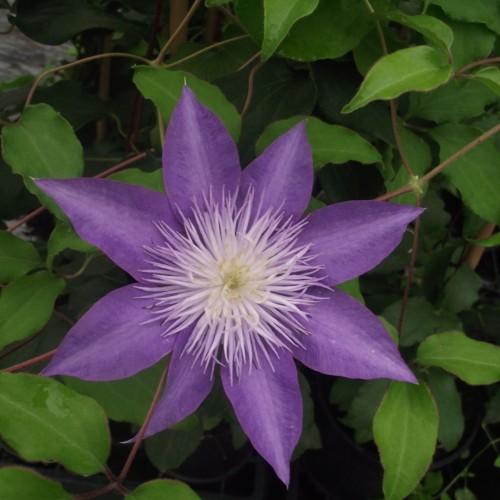
clematis
Clematis 'Evipo038' CRYSTAL FOUNTAIN
Cycle:
Perennial
Watering:
Average
Hardiness Zone:
4 - 8
Flowers:
Flowers
Sun:
Full sun,part shade
Leaf:
Yes
Growth Rate:
High
Maintenance:
Low
Care Level:
Medium
watering
Watering for Clematis 'Evipo038' CRYSTAL FOUNTAIN should be done regularly but not too often. Depending on the climate and the time of the year, the plant may need weekly watering. However, it's best to wait until the soil begins to feel dry before adding more water. During the summer, water once or twice a week with a generous amount of water. During the winter, the plant may require only occasional watering, depending on the weather conditions. If the soil is dry and the plant looks stressed, give it a deep soak, but otherwise let it rest until the soil feels dry.
sunlight
For optimal growth, it requires 6-8 hours of full sun each day. Sunlight should be provided in the cooler parts of the day, such as morning or late afternoon. Avoid direct contact with hot midday sun because too much summer heat may scorch the foliage, reduce flowering, and lead to plant stress. If you live in a warmer climate, try to place your Clematis in a location that gets some shade in the afternoon. Make sure the soil does not dry out, as this can stunt your plant's growth.
pruning
When it comes to pruning a clematis plant, the best time to do it is in late winter or early spring. It should be pruned lightly, only taking off dead or diseased wood, and removing approxiamately 1-third of the stem length. After pruning, give the plant some TLC by applying a slow-release fertilizer and a layer of mulch. This will help to promote new flowering growth.
FAQ
Can Clematis plants grow in pots?
Yes, Clematis plants can definitely be grown in pots. When planting a Clematis in a pot make sure to use a larger size pot with drainage holes and fill it with a mix of well-draining potting soil and compost. Ensure to keep the root area cool and the pot in a sunny location while providing regular water and fertilization. Check the plant almost daily to make sure it is not becoming too dry. Clematis can do well in a pot and with the right care and conditions, they will thrive.
Are Clematis plants self-pollinating?
No, clematis plants are not self-pollinating. Clematis plants need pollinators such as bees, butterflies, moths and other insects to transfer pollen from the male anthers to the female stigma of the flower in order to produce viable seed. Pollination must also occur within relatively close proximity of the same species in order to create viable hybrid plants.
Can Clematis plants be grown as a houseplant?
Yes, Clematis plants can be grown as a houseplant. It is best to grow them in a pot with full sun and a soil that is rich in organic material and retains moisture. When potting the plant, place a stake or trellis next to the pot so that the vine can climb when it begins to grow. Be sure to water your Clematis plant regularly to keep it healthy and growing. Additionally, keep an eye out for pests and treat with natural insecticides as necessary.
Could Clematis plants survive in a colder climate?
Yes, Clematis plants can survive in colder climates with proper preparation. If planted in the fall, proper mulching should be done to protect the roots from cold temperatures. If planted in the spring, they should be watered frequently to help them adjust to the cooler temperatures more quickly. If temperatures drop below -20°C ( -4°F), additional measures may need to be taken such as the application of protective wraps and thermal insulation. Additionally, plants in exposed areas should be protected from the wind to prevent excessive dehydration. With the right measures in place, Clematis plants can easily survive in colder climates.
Could Clematis plants be grown in a greenhouse?
Yes, clematis plants can be grown in a greenhouse. Due to their vine-like growth habit and tropical native origins, clematis plants thrive in the moist and warm environment of a greenhouse. Clematis are generally grown from cuttings or from dividing existing plants, and benefit from regular pruning and fertilizing. They will also enjoy the indirect light of a greenhouse and the protection from strong winds and temperatures that the humidity and contained environment provides.
